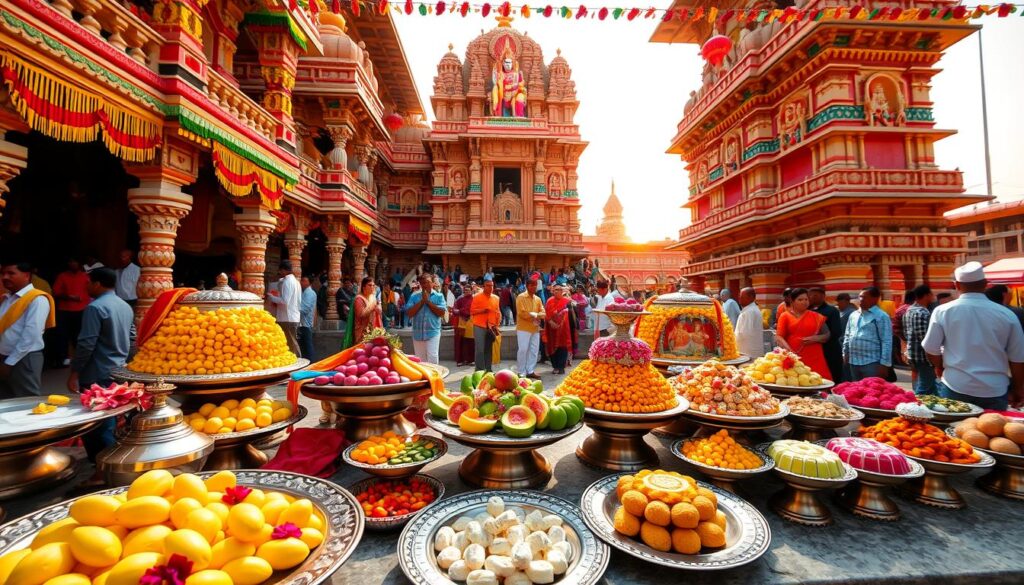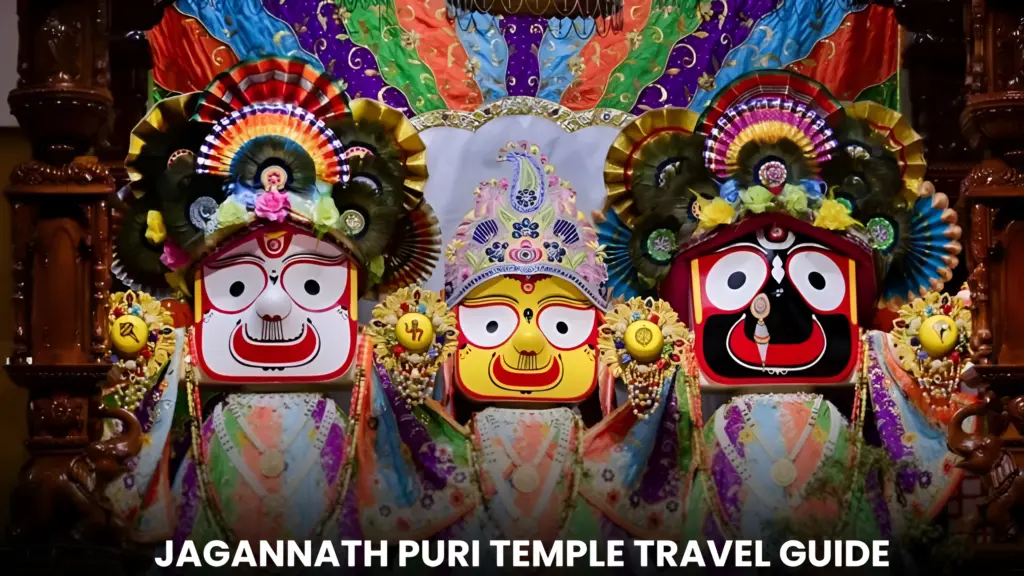Planning a trip to the Jagannath Puri temple in Odisha, India, can seem tough. But with the right info, you’re set for a spiritual journey. The temple’s history goes back to the 12th century. It’s a key spot in the holy char dham abodes of God.
The temple is about two hours south of Bhubaneshwar, Odisha’s capital. It draws millions yearly. Knowing the temple’s history, rituals, and customs is key. Also, find out the best visit times and how to get there.

This travel guide has everything you need for your trip. We cover the temple’s history, best visit times, and what to expect. Whether you’re a devout Hindu or curious about Indian culture, this guide is for you. It will help you explore the Jagannath Puri temple’s wonders.
The Sacred History of Jagannath Puri Temple
The Jagannath Puri temple has a rich history that spans centuries. It’s located in Odisha, India, and is a top pilgrimage site. Its architecture, with intricate carvings and a grand structure, is awe-inspiring.
The temple was built in the 12th century, finishing in 1161 CE. King Anantavarman Chodaganga Dev started it, and King Ananga Bhima Deva finished it. Its design shows its historical and cultural value, making it a key spot for those interested in architecture.
Visitors to Jagannath Puri temple should know its significance. It’s dedicated to Lord Jagannath, a form of Lord Vishnu. The temple complex is huge, covering ten acres, with the main structure standing 214 feet tall. Its history and architecture make it a place of spiritual wonder.
Origins and Legends
The Jagannath Puri temple’s origins are filled with legend and myth. It’s said to have been built by King Indradyumna after a dream. The temple’s carvings and structure show its deep spiritual importance.
Understanding the Spiritual Importance of Lord Jagannath
Lord Jagannath is seen as a form of Lord Vishnu, sent to earth to protect us in the Kali Yuga. The jagannath puri temple festivals are key to the spiritual scene. The Rath Yatra, a major event, draws millions every year.
The jagannath puri temple timings are set to welcome the many visitors daily. These numbers can range from 2,000 to 20,000 people.
The image of Lord Jagannath came from the sea and is now Puri’s iconic deity. Devotees bring flowers, fruits, and prayers to the Jagannath Temple. The temple’s design means it never casts a shadow, adding to its mystique.
Legend says no birds or planes can fly over the shrine. This is seen as a divine rule, not made by humans. For about 1800 years, a priest has climbed the temple to replace the flag. The temple is as tall as a 45-story building.
The jagannath puri temple timings and jagannath puri temple festivals show the temple’s spiritual value. They highlight the people’s devotion and faith. The Jagannath Puri temple is a place of deep spiritual significance, a must-see for those interested in Lord Jagannath and Hindu mythology.
Complete Jagannath Puri Temple Info for Visitors
The Jagannath Puri temple is in the heart of Puri. It’s a major pilgrimage site, drawing millions yearly. Knowing the temple’s facts, like its location and timings, is key. It’s open from 5 a.m. to midnight, best visited early morning or late evening to dodge the crowds.
The temple is easy to find, making planning your visit simple. Visit after the first aarti ritual, around 7 a.m., or after 9 p.m. for a quieter experience. With a 4 out of 5 star rating, it’s a top spot for those interested in India’s history and culture.
Temple Opening Hours
The temple is open from 5 a.m. to midnight. This allows visitors to come and worship at their convenience. Remember, it can get busy, so plan your visit wisely.
Dress Code Requirements
Visitors must dress modestly, following the temple’s traditional dress code. This helps keep the atmosphere respectful and peaceful for everyone.
Photography Rules
Photography is allowed in some areas, but it’s important to follow the rules. This prevents any disruptions or disturbances.
Entry Guidelines
Following the entry guidelines is crucial for a smooth visit. This includes the dress code and photography rules. Doing so lets visitors fully enjoy the spiritual experience and remember their visit to the jagannath puri temple.
Marvel at the Temple’s Architectural Magnificence
The jagannath puri temple architecture is truly stunning. Its intricate carvings and ancient building techniques have lasted for centuries. When you visit, you’ll be amazed by the inner courtyard, reached by 22 steps from the main gate. The courtyard is surrounded by about 30 smaller temples, making it even more impressive.
The main temple is a blend of Kalinga and Orissan styles. It has tall spires and large courtyards. The walls and pillars are covered in detailed carvings, showing the skill of the artisans. The temple’s construction in the 12th century is a marvel, thanks to ancient building methods.
Main Temple Structure
The temple has four main parts: the Vimana, Jagamohan, Nata Mandir, and Bhoga Mandap. Each part has unique architectural features. The outer wall, Meghanada Pacheri, is 20 feet high, making the temple even more impressive.
Intricate Carvings
The temple’s walls and pillars are covered in intricate carvings. These carvings show scenes from Hindu epics, highlighting the artisans’ skill. The carvings add to the temple’s beauty, making it a must-see for architecture and history fans.
Ancient Building Techniques
The temple’s construction shows the ingenuity of its builders. It uses stone and wood, along with intricate carvings and ancient techniques. Visiting the temple is a memorable experience, thanks to its architectural wonder.
Essential Rituals and Daily Ceremonies
The Jagannath Puri temple is filled with daily rituals. Over 20 rituals are performed every day. These reflect our daily activities like bathing and eating. The temple’s schedule is packed to keep all rituals on time.
The rituals begin at 4:30 am and go until midnight. Many ceremonies and offerings happen throughout the day. The morning meal, Sakal Dhupa, includes Khachudi, Kanika, and more.
The temple’s kitchen is huge, serving thousands quickly. Sevaks, Puja Panda, and Brahmans carry out these rituals with dedication. The temple’s rituals show its deep spiritual heritage and importance to devotees.
Famous Festivals and Celebrations
The Jagannath Puri temple is famous for its lively festivals and celebrations. These events draw millions of pilgrims and tourists from around the world. The Rath Yatra festival is a highlight, where the gods are carried on huge chariots through Puri’s streets.
This festival is a sight to see. The chariots are pulled by devotees using long ropes made of coir. These ropes symbolize good deeds and atonement for wrongdoings.
The Chandan Yatra marks the start of chariot building and lasts 42 days. The jagannath puri temple timings for this festival are well-planned. This ensures a great experience for everyone.
After the Chandan Yatra, the Snana Yatra takes place. It’s a ritual where the deities are bathed and dressed in new clothes and ornaments. This shows the temple’s rich cultural heritage.
Visitors can plan their visit to the Jagannath Puri temple based on the jagannath puri temple timings. The temple’s festivals and celebrations add to its charm. By attending these events, visitors can experience the temple’s vibrant culture and traditions.
Making Sacred Offerings at the Temple
Making sacred offerings at the Jagannath Puri temple is a key part of the spiritual journey. Devotees can join the 56 Bhog ritual, offering 56 different foods to Lord Jagannath every day. This tradition shows the area’s rich culinary heritage and deep faith, seen as very lucky.
The offerings are made in clay pots over wood fires, using traditional methods and strict rules. Visitors to the temple can help with the 56 Bhog ritual by giving ingredients or money. The food is made without onion or garlic, sticking to strict vegetarian rules.
The Mahaprasad, or sacred food, is then given to the devotees. It’s seen as a direct gift from Lord Jagannath.

The Jagannath Puri temple is a major pilgrimage spot. The tradition of making offerings is a big part of its rituals. Devotees can take part in the 56 Bhog ritual and get the Mahaprasad, seen as a sign of unity and equality.
The temple’s kitchen works all day to make fresh offerings for the deities. This ensures Mahaprasad is available every day as part of the temple’s rituals.
Planning Your Visit to Puri
Puri is just under two hours south of Bhubaneshwar, Odisha’s capital. You can fly into Bhubaneshwar Airport, the closest one. To enjoy your visit to the jagannath puri temple, plan carefully. The best time to visit is from October to March, with nice weather and low humidity.
Summer, from April to June, is the peak pilgrimage season. But, it’s very hot, up to 45°C. The monsoon from July to September brings heavy rain and thunderstorms. Always check the jagannath puri temple info before you go for a smooth trip.
Puri offers many attractions like the Jagannath Temple, Puri Beach, and Chilika Lake. It’s rich in history, culture, and natural beauty. By planning well and knowing about visiting jagannath puri temple, you’ll have a great time in this amazing city.
Puri has something for everyone, whether you love history, culture, or just relaxing. Its stunning architecture, beautiful beaches, and lively festivals will impress you. Start planning your visit today and explore Puri’s wonders for yourself.
Nearby Attractions and Sacred Sites
Visiting the jagannath puri temple location opens up a world of nearby attractions and sacred sites. The temple’s rich history and cultural significance make it a must-see for travelers. Raghurajpur, a handicraft village, is just a 15-minute drive from Puri.
In Raghurajpur, artisans work on their crafts right in front of their colorful houses. Other attractions include Konark, Chilika Lake, Pipili, and Astaranga Beach. Each offers a unique look into the region’s culture and history.
These places are not just culturally and historically important. They also show the daily life and traditions of the locals. Exploring these sites helps visitors understand the jagannath puri temple’s significance.
Whether you’re into history, culture, or just want to see how locals live, there’s something for you. So, take some time to explore these amazing places and see the region’s beauty for yourself.
Your Sacred Journey Awaits: Next Steps for Temple Darshan
As you get ready to visit the Jagannath Puri Temple, it’s key to know the current rules. The inner sanctum where the deities are kept is closed due to government rules. But, you can still feel Lord Jagannath’s presence through the jagannath puri temple offerings and daily rituals.
The temple opens around 5:30 AM for morning rituals and offerings. You can see these from the Jagamohan (Bhitar Kaatha) area. For a quieter experience, try visiting late in the evening.
Be sure to be quiet and follow the dress code and photo rules. The temple staff can help with any questions. By joining in the temple’s traditions, your visit will be deeply meaningful.
FAQ
Q: What is the significance of the Jagannath Puri temple?
A: The Jagannath Puri temple is a key pilgrimage site in India. It’s famous for its rich history, stunning architecture, and spiritual value. Dedicated to Lord Jagannath, an avatar of Lord Vishnu, it’s vital in Hindu mythology and devotion.
Q: When was the Jagannath Puri temple constructed?
A: The temple’s history goes back to the 12th century. The current building was constructed in the 12th century. Over time, it has been renovated and expanded, showing its lasting importance in Hindu traditions.
Q: What is the significance of Lord Jagannath in Hindu mythology?
A: Lord Jagannath is seen as a form of Lord Vishnu. He is deeply revered as a divine being. The temple’s festivals, like Rath Yatra, celebrate his spiritual significance to followers.
Q: What are the key festivals and celebrations associated with the Jagannath Puri temple?
A: The temple is known for its lively festivals. These include Rath Yatra, Chandan Yatra, and Snana Yatra. These events are spiritually and culturally significant, drawing millions of devotees.
Q: What should visitors expect when visiting the Jagannath Puri temple?
A: Visitors will be amazed by the temple’s beauty, spiritual depth, and cultural richness. There are specific rules, like dress codes and photography restrictions, to ensure a respectful visit.
Q: What are the unique architectural features of the Jagannath Puri temple?
A: The temple is famous for its detailed carvings and grand structure. Its construction showcases ancient building techniques. Visitors can admire its architectural splendor, highlighting its historical and religious significance.
Q: What kind of offerings can visitors make at the Jagannath Puri temple?
A: Visitors can offer prasad, special puja services, and donations. These offerings are spiritually significant and enrich the visit.
Q: What are some nearby attractions and sacred sites that visitors can explore?
A: The Puri region has many attractions and sacred sites. These include beach temples, landmarks, and cultural spots. Exploring these can deepen the visitor’s experience of the area’s rich culture and spirituality.


